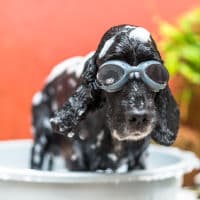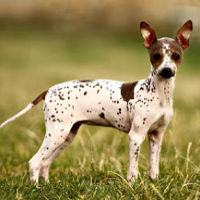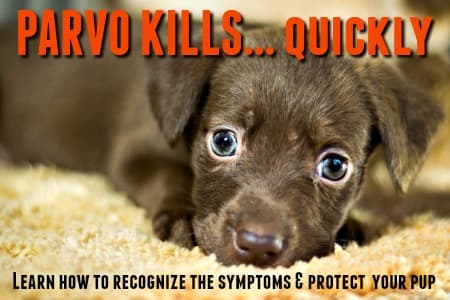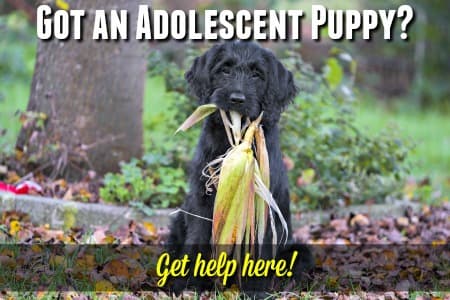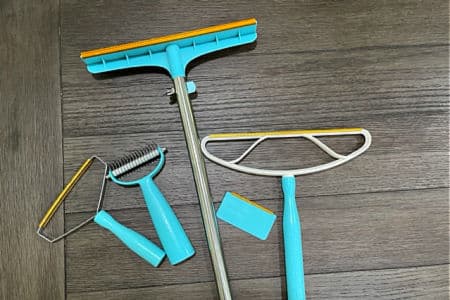FYI: If you buy something through a link on this site I may earn a commission - at NO extra cost to you.
Dog Shedding - A 'Hairy' Situation!
Dog shedding is a totally normal process and something that you can't totally stop or 'cure'. Let's face it, unless you own a hairless breed having dog hair on your floors, clothing and furniture is pretty much just a fact of life.
But don't despair, I'm going to share some practical tips and advice on this page for how to reduce your dogs shedding and minimize the mess all that loose hair causes.
We'll also take a look at different coat types, what can cause excessive shedding, the best ways to keep your dog's coat, and his skin, in good condition to reduce the amount of hair he loses, and the health issues that can potentially cause Fido to lose too much hair.
Your dog's hair is continually growing and then falling out (much the same way as ours does), and this 3-part cycle can last anywhere from a month to a year depending on the breed and coat type.
The three parts are:
- Growth phase (new growth in the hair follicles)
- Transition phase (when growth is complete and the hair is 'resting')
- Loss phase (the 'old hair' is lost and new hair starts to grow again)
The Transition phase of a dog's hair growth is the shortest one, and the longer the Growth phase the less shedding you'll see as there is a longer time between the Growth and Loss phases.
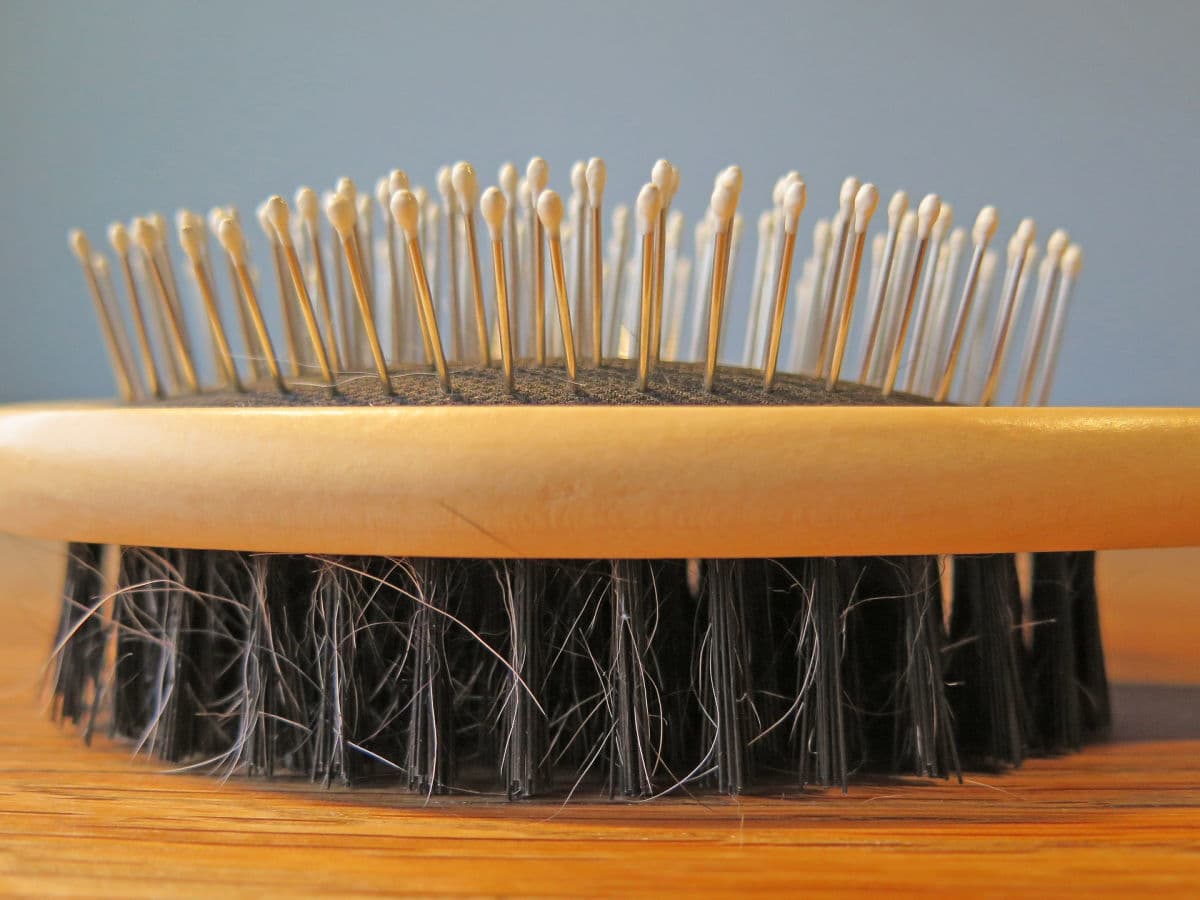
Major shedding usually happens twice a year during the major change of seasons (in Spring and again in Fall) and is called 'blowing coat'... it also often happens in a female dog after she's had a litter.
During the middle of the summer, and winter, your dog's shedding may settle down somewhat. However, most dogs shed year round, to some degree.
How Breed & Coat Type Affect Dog Shedding
The biggest clue to how often, and how much, a dog's coat will shed, are in his breed or genetic make-up. This is because certain types of coat shed more often or more excessively than others.
There are several ways to describe the different types of dog coats:
Single or Double Coat
A single coat is just one layer of hair/fur. A double coat (as you would expect) has two layers, usually a thick, wooly undercoat and a smoother top coat. These thick undercoats help to keep them warm, or cool (surprisingly true) and protect the dog's skin against the elements and environment.
Type of Coat
Although dogs are generally considered to have fur, some dog coats are more like hair (imagine a Yorkshire Terrier's long, silky coat). Hair like coats seem to have a longer growing phase than fur like coats, which means they shed less often. Curly coats on dogs such as Poodles (and their offspring the Doodles), Bichon Frises and Coton de Tulears, tend to shed less and are considered low shedding breeds. Then there are the wire coats. These are strong, wiry, double coats which are also low shedding (but do need regular clipping and stripping to keep the coat mat free and in good condition).
Texture of Coat
A single coat of short smooth hair literally falls right off a dog's body.. and onto your floor, furniture, clothing etc. A thicker, wavy coat tends to hold onto loose, dead hair more easily so although the shedding may be of a similar amount, there may be less on the floor but more on the brush. Thick double coats can work the same way.
Breed type is relevant to dog hair loss because the coat is a characteristic which is linked to the breeds original purpose.
For example, breeds that were originally created to live/work outdoors (especially in cold climates), such as German Shepherds, Newfoundlands, Siberian Huskies, Alaskan Malamutes, Saint Bernards, Great Pyrenees, Chow Chows, Pomeranians and so on have tons of hair - both the longer 'outer-coat' hairs and the softer, denser undercoat.
Double coats like this 'blow' big time in late Spring! Clumps of soft undercoat 'poof' off their bodies and roll/blow across hard floors like hairy tumbleweeds... or stick to every soft surface you have. My plush-coated German Shepherd is a prime example of this and I vacuum many times a day in the late Spring/early summer.
Some dogs have a shorter double coat, such as Rottweilers and Labrador Retrievers and they can also lose large amounts of hair due to shedding.
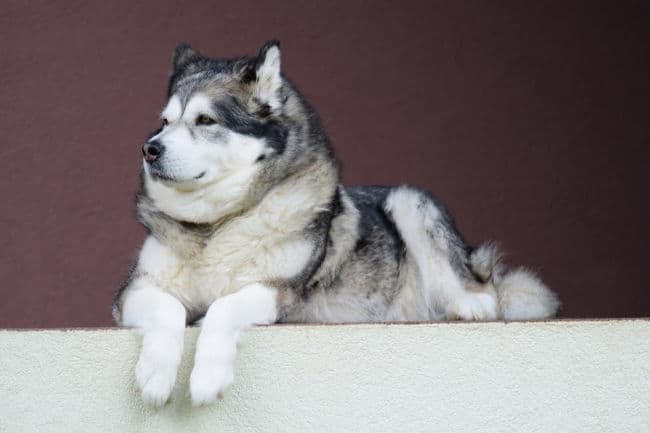
Which dog breeds shed the most?
Some of the breeds who are going to give you the hairiest headaches include:
- Akita
- Alaskan Malamute
- Bernese Mountain Dog
- Corgi
- Chow
- German Shepherd
- Golden Retriever
- Great Pyrenee
- Labrador Retriever
- Saint Bernard
You'll notice the working-dog theme here!
Dog breeds who have long, silky outer-coats and little, or no, undercoat are low shedders, so are those with curly coats and some wire-haired breeds.
which dog breeds shed the least?
Obviously hairless dogs don't shed, and those include the American Hairless Terrier, the Peruvian Inca Orchid and the Chinese Crested.
Low shedding breeds include:
- Affenpinscher
- Afghan Hound
- Bichon Frise
- Brussels Griffon
- Cairn Terrier
- Coton de Tulear
- Irish Water Spaniel
- Irish Terrier
- Maltese
- Poodle
- Portuguese or Spanish Water Dogs\
- Scottish Terrier
- Shih Tzu
- Schnauzer (Giant and Standard sizes have the same type of coat)
- West Highland White Terrier
So, to sum it up... pretty much all dogs shed (except hairless ones) but that's not any real consolation for dog owners who spend what seems like half their waking hours removing dog hair from their clothes, furniture, carpets... even coffee cups - and I'm one of them!
How To Reduce Your Dog's Shedding
Although there's no 'magic bullet' that will stop your dog from blowing coat, or gradually depositing his hair all over your carpets, furniture and clothing, there are a few things that you can do to reduce the amount of loose hair he has to share with the world.
Removing it from his coat manually (basic grooming), before it falls out by itself, can really help.....
REDUCE SHEDDING WITH REGULAR GROOMING
When it comes to controlling or reducing the amount of hair your pet is losing, regular and proper grooming is the key.
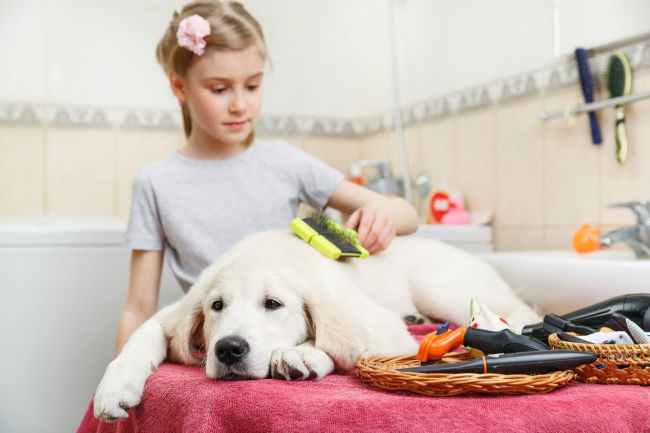
If you groom your dog regularly, you will have much more control over his shedding, and you can remove an amazing amount of hair in a fairly short time with the right dog grooming tools/equipment.
In addition to regular brushing, regular baths can also help to remove loose hair and dander.
Bathing once or twice a month should be enough, although if you or someone else in your family has an allergy to dog hair, it might be a good idea to bathe weekly, as long as it doesn't irritate the dogs' skin.
Always remember to use a very mild shampoo such as a puppy formula, Oatmeal Shampoo or hypoallergenic formula (no medicated or highly-scented ones please!).
There are even a whole range of special dog shedding shampoos such as FURminator deShedding Shampoo.
If you or someone in your family has allergies, this Anti-allergen Pet Shampoo can really help reduce the dog dander that's the number one trigger for sneezing, itching and other common dog allergy symptoms.
Using the right brush or grooming tool for your dog's coat type is important too, so here's a quick look at the best tools to keep dog shedding to a minimum in different breeds:
Dogs with thick double coats
For this type of coat you need a rake, such as this this dematting comb which will make sure all the loose hair is removed properly. A simple comb or bristle brush won't be enough to get the job done! Double coats like this need daily grooming if possible, and at a minimum three times per week.
Dogs with long, silky hair
For dogs with hair-like coats, a metal grooming comb and a slicker brush (these are wide, flat brushes with bent wire teeth) are the best choice. This type of coat can be fairly high-maintenance in terms of grooming needs, so be prepared for daily grooming sessions. Some of these breeds need their coats to be regularly 'stripped' or 'plucked' (Spaniels and Setters for example).
Dogs with short, wiry coats
Many terriers (such as the Carin Terrier, Jack Russell Terrier and Wire-haired Terrier, among many others) have a soft undercoat and a tough, wiry top coat. To reduce excessive shedding in these breeds you'll need a steel comb (see paragraph above for link) and a pin brush to remove the hair at both levels. This type of dog coat also needs stripping or plucking, and it's best to have this done by a professional groomer. Alternatively you can have this type of wire coat clipped short and trimmed every two to three months.
Dogs with smooth, short coats
These breeds are the easiest to groom and have the least labor intensive coat. This group includes dog breeds like the Boxer, Bulldog, Weimaraner, Doberman and some Hounds... and many others. For this type of coat, a twice weekly date with a bristle brush may be enough to keep shedding to a minimum.
Regular grooming at home is the best way to keep your dog's shedding under control but, depending on his coat, visiting a professional dog groomer for a bath, trim and thorough grooming can make a huge difference!
I have a plush coated German Shepherd who sheds more than any dog I've ever owned, and regular groomer's visits (plus extra ones during that 'blowing coat' stage) keep me sane but he still needs to be groomed daily.
Furminator and Uproot Clean's deshedding toolslare my go-to's and really do reduce the amount of fur he spreads around the house. Keeping him brushed and tangle free also means he costs me less at the groomers so it's a win-win!
More Ways To Reduce Dog Shedding
Here are a few other things which can contribute to excessive shedding and hair loss in dogs, and suggestions for how to combat them...
Diet
Diet can play a role in hair loss and of course proper nutrition is the foundation for good overall health, so feeding a high-quality diet using a premium dog food that has all the nutrients your pet needs is very important. Avoid cheap dog food or generic brands as these often contain chemicals and additives, and don't nourish your dog. Both a poor diet, and dog food allergies can also cause skin and coat problems, including dull, coarse fur, hot spots, excessive hair loss and more.
Supplements
There are also 'anti-shedding' supplements and natural products that may help. Generally they contain different oils which are known to improve the condition of a dogs' coat and skin.
Fatty acid supplements and fish oils can really improve the condition of your dog's skin and coat. The all natural Naturals Royal Coat Express is a great choice, and is packed full of essential fatty acids (Omega-3 and Omega 6) which may not be present in sufficient levels in your dogs food.
Adding coconut oil or olive oil to your dogs food can also help improve the condition of his skin and coat. Given daily this can improve the health and condition of your dogs skin and give him a shiny, healthy coat and healthy coats often shed less!
Hydration
Making sure your dog is properly hydrated and always has access to clean, fresh water is also important in terms of keeping your dogs skin and coat in good condition. Dehydration can lead to serious health problems, but non life-threatening ones like dry skin and coat can affect the amount of fur or hair your dog loses.
Health issues
If your puppy or dog is losing more hair in some areas than others and has bald spots, a patchy coat, or skin irritation alongside the hair loss, then you need to have your veterinarian examine him.
In addition to allergies, fungal infections or parasites can cause hair loss in puppies and dogs, and conditions such as Mange or Ringworm can only be diagnosed by your veterinarian.
Whether your dogs' shedding is due to normal breed/coat type and seasonal/developmental fluctuations or allergies or disease, all of that hair floating around your home can drive you nuts!
That's why I decided to take a closer look at some pet hair remover tools (that go beyond your standard lint rollers!) for clothing, furnishings and cars.
You can find the three that I love (they're all you need for keeping fabrics fur-free!), read my personal reviews and find out why I think they're so great on this page... Dog Hair Removers - My Reviews .
you might also like...
- Home
- How to Groom a Dog
- Dog Shedding
FTC Disclosure: Some pages on this site contain affiliate links. I may earn on qualified purchases.
